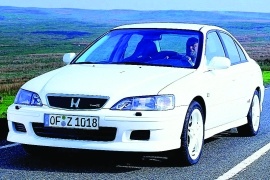HONDA Accord Type R Models/Series Timeline, Specifications & Photos
First production year: 1998
Engines: Gasoline
Honda introduced the sixth generation of the Accord in European clothing in June 1998 and also announced the introduction of a more performant version of it named the Type R.
While the previous generation of the Accord was available in sports clothing for specific markets, Europeans had to use less-powerful versions of their cars. That didn’t appeal to them and persuaded the automaker to create one, especially for them. Since the Japanese automaker had already established a factory in Swindon, UK, where it built the Euro-spec vehicles, it wasn’t that difficult to adapt the already existent H22A7 engine and plant it under the car’s hood. Besides that more potent powerplant, the car also got some styling changes and a unique interior that was pleasant for those customers eager to get a family sedan with sports car performance.
The Japanese automaker made some subtle changes to the front of the 1998 Honda Accord Type R, also known as the CH1, that differentiated it from the rest of the range. While the hood and the headlights looked identical to those from the regular Accord, the grille and the bumper were unique to the model. The pentagonal-shaped grille pointed downwards sported a red Type R badge on the left lower side, while the chromed H logo took center stage. Further down, on the apron, the automaker placed a broad, reversed trapezoidal air intake flanked by a pair of side scoops that cooled the front rotors. The automaker didn’t offer fog lamps for the car.
From its profile, the 1998 Honda Accord Type R revealed its true character through a few details. The automaker installed unique 17” light-alloy wheels with a five double-spoke design available in white or silver. A keen eye for detail could notice that the ground clearance was slightly lower than on the regular Accord, but not significantly. Also, it is worth mentioning that the Accord Type R was exclusively offered as a four-door sedan, while its non-R badged stablemate was also available as a hatchback. Furthermore, on the lower sides of the rear doors, Honda put a pair of stickers with the Type R logo. At the back, the short and tall deck could be decorated with a massive rear wing as standard, depending on the country. However, that was the only “look-at-me” element from the entire vehicle. Finally, under the rear valance, the automaker placed two exhausts on the sides.
Since Honda had to put the car on a diet to lose some weight, the Accord Type R’s interior was different than the rest of the Accord V range. It featured sports seats with integrated headrests and high bolstered areas that kept their occupants in place during high-speed cornering maneuvers. The dashboard was similar, but the car wasn’t available with air conditioning. Fronting the driver was a redesigned instrument panel featuring white dials and red needles. Moreover, Honda deleted the option for a sunroof in the car and also saved some weight by placing fewer sound-deadening materials in and around the cabin. In the back, the bench seat provided enough comfort for two passengers. There was, in fact, a third place for a middle-seated occupant, but that place was cramped and suffered from a lack of legroom and headroom.
However, customers looking for the Accord Type R were concerned about the car’s underpinnings. Honda used a new platform with a shorter wheelbase than the previous generation of the Accord. The car used a braking system carried over from the NSX supercar and stiffer suspension. The 2.2-liter powerplant sent 212 PS (209 hp) to the front wheels via a five-speed manual transmission featuring a helical torque-sensitive limited-slip differential.
